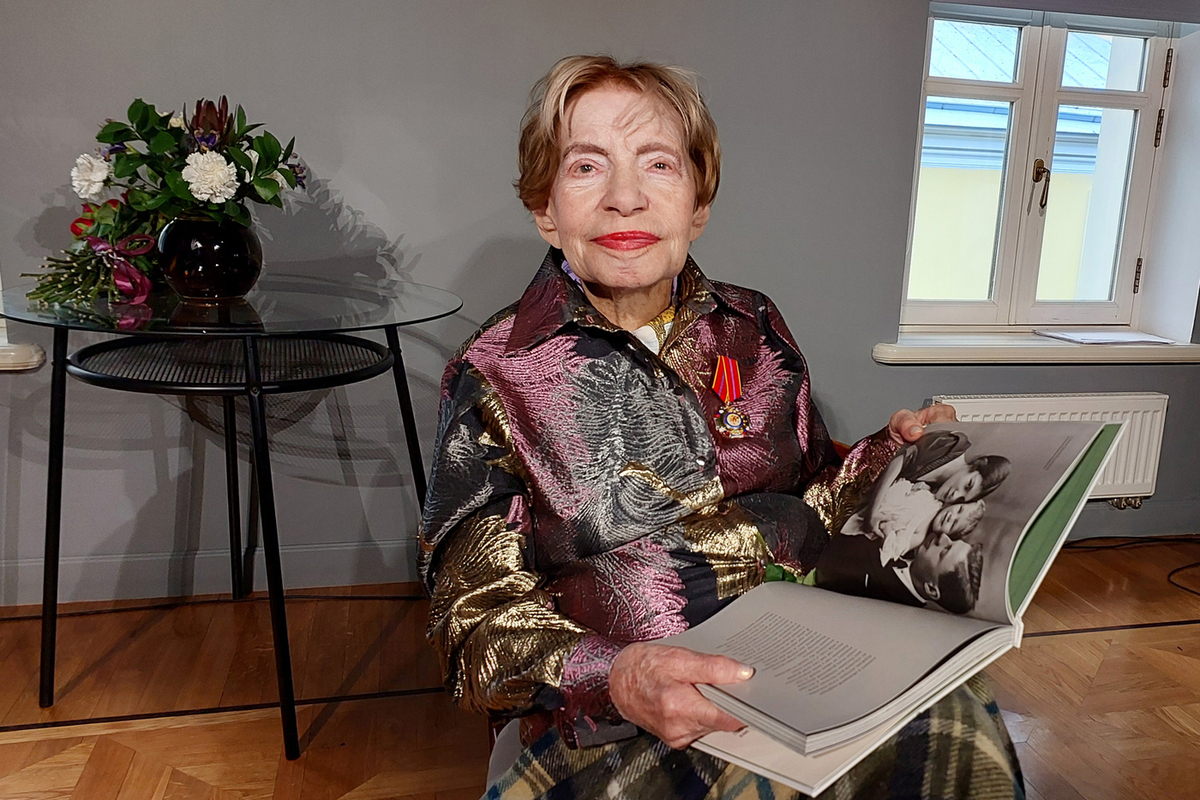Zoya Boguslavskaya, on the eve of her 100th birthday, opened the exhibition “Always Zoya. Exhibition novel”
[ad_1]

“I love people very much. This is my hobby”
On the occasion of the 100th anniversary of Andrei Voznesensky’s writer, playwright and muse Zoya Boguslavskaya, the Voznesensky Center opened the exhibition “Always Zoya. Exhibition novel.” Her heroine was not only present, but answered questions from journalists for four hours, signed books, greeted guests, and received the Order of Merit in Culture and Art from the hands of Minister of Culture Olga Lyubimova.
Boguslavskaya, like Bulgakov’s Margarita, stoically accepted the kisses and admiration of the guests. She could fly away on a broomstick in her shimmering brocade dress. No one would be surprised. She came to the exhibition from Peredelkino. A surprise awaited her at the entrance – her son Leonid Boguslavsky himself, who specially flew in from afar and came out to meet her with flowers. The hero of the day was grabbed by the arms and carried like a whirlwind through the halls, accompanied by dozens of cameras.
“It’s touching to the point of tears,” Zoya Borisovna repeated. – Where did you get all this? This is my nurse… Directors Alov and Naumov… They invited me to Mosfilm. I was shocked by their proposal… This is not an exhibition, but a history of the issue.” Near the installation with skis, a black bird and a bucket, Zoya Boguslavskaya noted: “There is no champagne in the bucket.” At the “House with a Handle” I read my own memories from the wall and stopped at a crib with a teddy bear. Then she demanded to film with her son: “Put your head on my shoulders. It will be very funny.” The fuss around was terrible.
The exhibition is conceived in reverse chronological order. First come relatively recent events – the creation of the Voznesensky Center, the presentation of the Triumph Prize, then a meeting with Voznesensky, two marriages, meeting her first husband – the young scientist Boris Kagan, the birth of a son, studying at GITIS… An entire hall is dedicated to Mosfilm, where Boguslavskaya worked in the sixth creative association, saving Tarkovsky. Childhood is a groovy ballerina, information about her parents, documents, photographs of her father and mother Emma Iosifovna, who suffered from the fabricated “doctors’ case.” There are biographical details on the stands. Here is one of them: “Zoya Borisovna is leaving for the maternity hospital from the Lenin Library, where she is currently working on her Ph.D. dissertation.”
The artist and exhibition architect Alexey Tregubov created several installations. One of them is an evacuation hospital in Tomsk, where young Zoya Boguslavskaya worked as a nurse during the Great Patriotic War. This is the staircase in the house in Peredelkino, reminiscent of the poetic lines of Voznesensky. They traveled a lot around the world, and the exhibition features two symbolic chairs from the plane.
According to Alexey, the emerald of the exhibition was an icon of an unknown author of the first quarter of the 16th century, “Archangel Michael” from a private collection. What does she have to do with Zoya Boguslavskaya? “When you look at a work that is 500 years old,” explains Alexey, “you begin to treat time nonlinearly. The icon relates to the theme of Mosfilm and the creation of Tarkovsky’s film Andrei Rublev. Zoya Borisovna contributed to his appearance.”
Boguslavskaya met and was friends with many outstanding people – Marc Chagall, Arthur Miller, Vladimir Vysotsky, Julio Cortazar, Gina Lollobrigida, Sophia Loren, President Kennedy… At the opening of the exhibition, she told how Voznesensky introduced her to Lilya Brik: “At first she was dismissive of me she reacted, then examined her quite deeply… Her encouragement was very important to Andrey.”
Alexey Tregubov explains: “It is impossible to reveal all one hundred years, but Zoya Borisovna gave us a chance to touch her life. I had a feeling that Andrei Voznesensky helped us create this exhibition. Thanks to him, everything fell into place. I wanted to avoid an academic story about a person’s life, so we decided to go in the opposite direction. Hence the name “Exhibition Romance.” This is largely a response to Zoya Borisovna’s memories.”
“The most important thing for me is people,” the heroine of the day admitted to us. – I love them. This is my hobby. I have met so many brightest people in my life! I traveled a lot, visited America several times, worked at Columbia University, worked in Paris and in Germany. My German is unaccented. French and English with some kind of flavor, and I speak German like a German, from the age of one to five I lived in Berlin, where my father worked at the Soviet trade mission.”
What is she dreaming about now? “To live the rest of your life without illness, not to be infirm, to have the strength to think and feel, that is, to be a conscious person. We live in troubling times, very unstable. It’s impossible to predict where it will go. I lived in harsh times. On the most difficult days, my mind helped me. I have a very strong thinking apparatus. I regret what I didn’t do. I conceived some books, but never wrote them. Now I continue to write. I will try to fit today into my book, talk about new people with whom I became friends. I became related to the hockey champion Vyacheslav Fetisov. My grandson is married to their descendant. I’ve been to their house a couple of times, but what I don’t have is time. It’s impossible to tear yourself apart and keep up everywhere.”
Newspaper headline:
Life in reverse
[ad_2]
Source link






